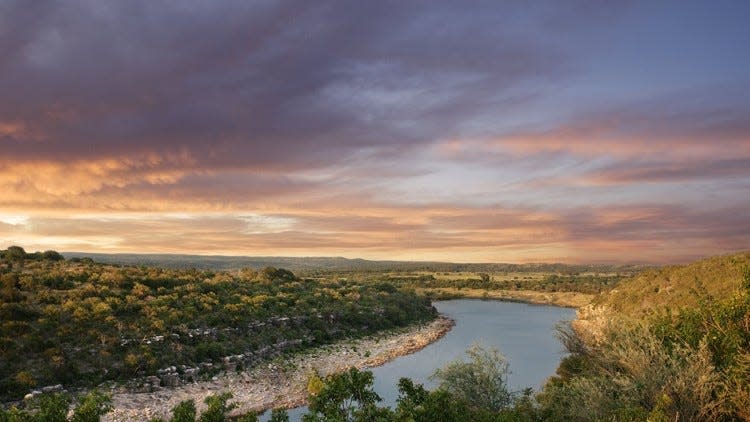The historical miracles of Marble Falls, Texas
Dear Texas history buffs,
It's amazing how much one can see during one Texas day trip.
Recently, I sketched out some destinations in Burnet County, located in the Hill Country about an hour northwest of Austin. I had visited several times in the past. This time, however, history buffs on the ground helped me find nuggets of the past hitherto unknown to me.
Today's column is devoted to the town of Marble Falls. I cover the Falls on the Colorado River Museum, pioneering mayor Ophelia Crosby "Birdie" Harwood, the Blue Bonnet Cafe, St. Frederick Baptist Church and its plans for a Black history museum, and Dead Mans Hole, a dumping ground for victims of pro-Confederate terror in the area.
In the coming weeks, I'll report on Burnet, the county seat, and Bertram, a former cotton and rail center in the eastern sector of the county.
In case you are wondering, most of Texas is still in varying states of drought. To learn more about historic droughts in the region, read last week's column on dry spells in the 1930s, 1950s and early 21st century. (The column ran on the front page of the Abilene Reporter-News.)
Great news: My four Think, Texas columns on a road trip to Corpus Christi and South Texas were published online by the Corpus Christi Caller Times:
Texas road trip: Tell us what to see, do and eat in Corpus Christi, and anywhere nearby
Our Think, Texas road trip to Corpus Christi just got bigger. Too big for one visit.
Here are 10 reasons Corpus Christi is the most promising city in Texas
Visiting shrines, missions, presidios, vaults and other hallowed places in South Texas
Miss a column? Go to our column archives.
Miss a newsletter? Go to our newsletter archives.
Sign up: To get the free Think, Texas weekly digital newsletter, go to the American-Statesman newsletter page, or that of your hometown USA Today newspaper in Texas.
THE COLUMN
Pioneering history: In Marble Falls, tales of a legendary mayor, a museum and those pies
MARBLE FALLS, Texas — A proposed Think, Texas column about a day trip to Burnet County swiftly grew into three separate columns, so fascinating were the historic towns of Marble Falls, Burnet and Bertram — and the people who live there. Today, we look at Marble Falls.
Located about an hour northwest of Austin, Burnet County, while still mostly rural, is growing swiftly.
The largest town, Marble Falls, rises sharply above Lake Marble Falls near the southern rim of the county. Tourists discovered it long before the Colorado River was impounded in 1951 by the Marble Falls Dam, later renamed Max Starcke Dam after the longtime director of the Lower Colorado River Authority.
It replaced the 40-year-old, incomplete Alexander Dam, located a short distance upstream, and a smaller dam that provided power for a textile plant in Marble Falls. (The book to read is "The Untold Story of the Lower Colorado River Authority" by John Williams.)
The town was founded in the 1880s by Confederate Gen. Adam Johnson, who was blinded during the Civil War. He was not directly related to "that other Johnson," I was reminded several times during my day trip. That's how locals referred to President Lyndon Baines Johnson, who was born not far away in Blanco County.
In the narrows of the Colorado River, the general planned an industrial paradise powered by rushing water from the 22-foot-deep, 250-foot-wide natural falls.

In the early 1880s, a nearby outcropping known as Granite Mountain — now hardly mountainous, but still producing beautiful granite today — was chosen as the source for the pink stones that face the Texas state Capitol.
A rail line from Austin that had already reached the cotton town of Bertram and the county seat of Burnet was extended to Marble Falls to service the quarry. (The Cedar Park-based Austin Steam Train Association has produced a dandy rail history of the region titled "Along the Granite and Iron Route.")
So were the town's titular falls, then, marble or granite?
Neither. The town was named for a shelf of light-colored limestone that runs diagonally across the river bottom.
THE PODCAST
On the latest episode of "Austin Found" podcast, J.B. Hager and I talk about the long, but interrupted history of the Austin Symphony. Closely associate with the city's German American community, it went silent between 1918 and 1938.

HOMETOWN HISTORY
This week's Hometown History theme is Mexican food.
· From Abilene: 'It was time': El Fenix ends 83 years in business in Abilene
· From Amarillo: Irma Leal leads restaurant through 60 delicious years in Texas Panhandle
· From Austin: It's not Tex-Mex: New documentary digs deep into Texas Mexican food, history
· From Corpus Christi: These stories can teach you about Corpus Christi's deep connection to Hispanic heritage

· From Lubbock: Montelongo was Mexican food pioneer, even in 1949
· Houston: 'The Original Mexican Restaurant,' but was it Houston's first?
· From San Angelo: Cole slaw served with Mexican food is definitely a San Angelo twist
· From Wichita Falls: El Fenix closes Wichita Falls restaurant suddenly over weekend
FUN TEXAS FACT
T&P Railway finally reaches Fort Worth, touching off celebration
On July 19, 1876, the Texas and Pacific Railway finally completed its line into Fort Worth. Construction of the line had stalled just 16 miles to the east, at Eagle Ford.
Eager to reach Fort Worth before the Texas legislature could revoke its charter and withhold its land subsidy, the T&P hired Welshman Morgan Jones to complete the line before the legislature adjourned. Work continued day and night, while a little more than a mile a day of track was laid.
A holiday spirit filled the town when Jones's line finally reached Fort Worth on time. The success made the Welshman a local hero and marked the beginning of a new era of growth for Fort Worth.
(Texas Day by Day / Texas State Historical Association) READ MORE
TEXAS TITLES
I recommend: "The Untold Story of the Lower Colorado River Authority" by John Williams
I mentioned Williams' definitive book on the historic water agency in last week's column. Let me reiterate that it belongs on every Texas history buff's shelves, since the Highland Lakes and other agency projects altered more than Central and Southeast Texas.
Happy Trails,
Michael Barnes, Columnist
Think, Texas and Austin American-Statesman

Email: mbarnes@statesman.com
Twitter: twitter.com/outandabout
This article originally appeared on Austin American-Statesman: The historical miracles Marble Falls, Texas

